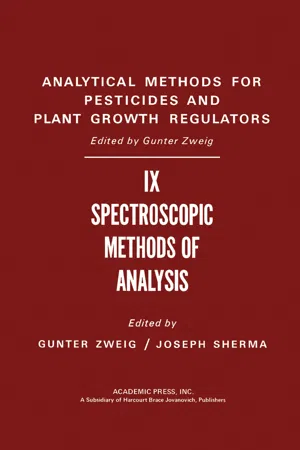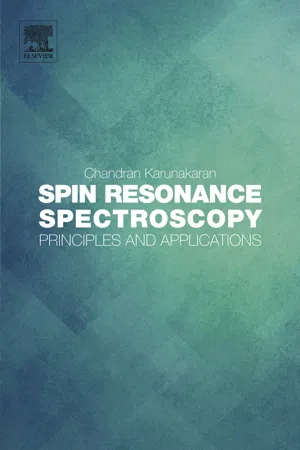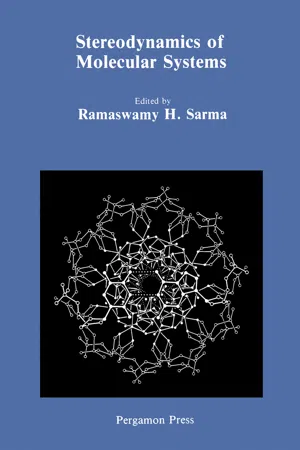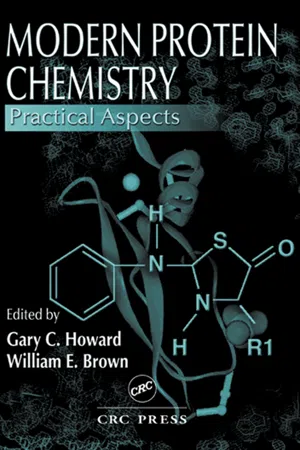Chemistry
Chemical Shift nmr
Chemical shift in NMR (nuclear magnetic resonance) refers to the displacement of a nuclear magnetic resonance signal in a magnetic field. It is measured in parts per million (ppm) and provides information about the chemical environment of the nucleus being studied. Chemical shift values are influenced by the electron distribution around the nucleus, making it a valuable tool for structural determination in organic chemistry.
Written by Perlego with AI-assistance
Related key terms
1 of 5
12 Key excerpts on "Chemical Shift nmr"
- eBook - ePub
Optical, Electric and Magnetic Properties of Molecules
A Review of the Work of A.D. Buckingham
- D.C. Clary, B.J. Orr(Authors)
- 1997(Publication Date)
- Elsevier Science(Publisher)
11 NMR chemical shifts: theory and experiment Cynthia Jameson, A review of reprinted paper [B54]: ; Medium effects in proton magnetic resonance. I. Gases W.T. Raynes, A.D. Buckingham and H.J. Bernstein J. Chem. Phys., 1962, 36, 3481–3488 Nuclear magnetic resonance spectroscopy is a powerful technique that is used very widely in the characterization of systems ranging from simple molecules in low-density gases to molecules in biological systems, whole tissues or even whole animals, as well as materials complex and heterogeneous, such as polymer blends and catalysts. The NMR parameter which permits the dispersion of nuclear resonance frequencies into separate signals at separations proportional to the strength of the applied magnetic field is the nuclear magnetic shielding. The difference between nuclear shielding values in two different nuclear sites is called the NMR chemical shift. The extreme sensitivity of the nuclear shielding to the electronic environment gives rise to the dispersion of resonances; for example the 13 C nuclei of the alpha carbons of the various alanine residues in a protein all have different resonance frequencies each of which is different from the free amino acid. In a series of papers [B40, B41, B54], Buckingham introduced the idea of additive contributions to NMR chemical shifts arising from molecular interactions with solvent molecules. The individual chemical-shift contributions identified are as follows: bulk susceptibility σ b, magnetic anisotropy σ a, electric-field effects σ E, and van der Waals σ W. These papers constitute the framework on which nearly all attempts at the interpretation of the relation of the proton chemical shifts in proteins to the secondary structure are based. In the recent past, the powerful multidimensional NMR methods of determining protein structure in solution made no use at all of the chemical shift information which is a natural byproduct of the resonance frequency assignment step - eBook - PDF
Spectroscopic Methods of Analysis
Analytical Methods for Pesticides and Plant Growth Regulators, Vol. 9
- Gunter Zweig, Joseph Sherma, Gunter Zweig, Joseph Sherma(Authors)
- 2013(Publication Date)
- Academic Press(Publisher)
These parameters will be described. II. CHEMICAL SHIFT The frequency at which a resonance signal is observed is a function of the electronic environment of the resonant nucleus. Spectra are dis-cussed in terms of low- ( -) or high- (+) frequency lines or shifts relative to some reference standard (Commission on Molecular Structure and Spectroscopy, 1972). Tetramethyl silane (TMS) is the most frequently 51 52 N. CYR, T. CYR, AND R. HAQUE used reference standard for various reasons such as inertness or high sen-sitivity (Tiers, 1958). There are charts of chemical shifts showing proton resonances f o r — C H 3 , — C H 2 — , aromatic protons, — N H 3 + , etc. Gener-ally speaking, signals from near electronegative substituents will appear at high frequencies (+), or if the spectrometer is designed to sweep the magnetic field rather than the frequency, these signals will occur at low fields (+). The same comportment is observed for the chemical shift of 1 3 C NMR signals. Chemical shift charts of 1 3 C resonances have been pub-lished (Tanaka et al., 1971). With the aid of charts similar to Fig. 1 for *H resonances and to Fig. 2 for 1 3 C resonances, compound identification is much simplified. In practice, direct comparison to spectra obtained from authentic samples is most rapid. For this reason, a library of spectra such as that of the Sad tier Laboratories, Philadelphia, is essential. A. Magnetic Nonequivalence When a proton experiences different environments due to chemical exchange or molecular motion, a composite signal representing each of the molecular species will be observed. However, when the molecular motion is rapid compared to the chemical shift differences expressed in units of frequency, the proton will yield a weighted average signal (Pople et al. } 1959, p. 218; Emsley et al., 1966, p. 484; Jackman and Sternhell, 1969, p. 35). - eBook - ePub
Spin Resonance Spectroscopy
Principles and applications
- Chandran Karunakaran, CHANDRAN KARUNAKARAN(Authors)
- 2018(Publication Date)
- Elsevier(Publisher)
ppm.Chemical shift , ppm δ =( Frequency of signal − frequency of reference )×10 6Spectrometer frequency( in Hz )The assignment of chemical shift values of each peak to protons in the functional group of molecules is given in Table 2.1 .The proton chemical shifts exhibit a range from − 20 (for metal hydrides viz ., [H-Rh(CN)5 ]3- ) to 40 ppm (for naked protons). But the majority of the organic compounds appear in the range 0–10 ppm.Table 2.1Typical selected 1 H chemical shift valuesProton δ (ppm) Proton δ (ppm) Aldehyde 9.5–10.5 CH3 attached to bonds 1.8–2.5 Aromatic 6.5–8.2 CH3 attached to aromatic 1.8–2.5 Alkene 4.5–6.1 Methyl (CH3 CO ) 1.8–2.7 Alkyne 2.0–3.2 Methylene ( CH2 O ) ∼3.6–4.7 Acetal 4.5–6.0 Methylene (CH2 R1 R2 ) ∼1.3 Alkoxy 3.4–4.8 Methine (CH R1 R2 R3 ) ∼1.5 Methyl (CH3 R) ∼0.9 Cyclopropane 0.22 N -methyl 3.0–3.5 Me4 Si (tetramethylsilane) 0.0 Methoxy 3.3–3.8 Metal hydride − 5 to − 20 2.3. Factors Influencing the Chemical Shift of Protons
2.3.1. Shielding in Nuclear Magnetic Resonance
Magnetic nuclei are shielded by valence electrons surrounding them, which circulate in an applied magnetic field. This generates a local diamagnetic current in the opposite direction (Fig. 2.1 ). This diamagnetic shielding will affect the frequency of radiofrequency (RF) radiation necessary to cause a nucleus to spin flip (the resonance frequency). Therefore, the nuclei will absorb radiation of slightly different frequencies compared with bare nuclei depending on their local magnetic environment, which is determined by the structure of the compound. Because the magnetic field strength dictates the energy separation of the nuclear spin states and, hence, the resonance frequency, different types of nuclei will occur at different chemical shifts. This makes NMR so useful and powerful for structure determination. Otherwise, all nuclei would have the same chemical shift. Thus, the chemical shifts of NMR provide a wealth of structural information about molecules [4] - Kenneth Williamson, Katherine Masters(Authors)
- 2016(Publication Date)
- Cengage Learning EMEA(Publisher)
These small varia-tions, called chemical shifts, are plotted versus signal intensity to produce the NMR spectrum. The interpretation of these signals and other spectral features such as splitting patterns and peak areas, as described in the following sections, facilitates organic structure elucidation. 1 H NMR: Determination of the number, kind, and relative locations of hydrogen atoms (protons) in a molecule. Chemical shift, δ (ppm) Nuclear Magnetic Resonance Spectroscopy CHAPTER 12 PRE-LAB EXERCISE: Outline the preliminary solubility experiments you would carry out using inexpensive solvents before preparing a solution of an unknown compound for nuclear magnetic resonance (NMR) spectros-copy using expensive deuterated solvents. 240 Copyright 2017 Cengage Learning. All Rights Reserved. May not be copied, scanned, or duplicated, in whole or in part. Due to electronic rights, some third party content may be suppressed from the eBook and/or eChapter(s). Editorial review has deemed that any suppressed content does not materially affect the overall learning experience. Cengage Learning reserves the right to remove additional content at any time if subsequent rights restrictions require it. 241 Chapter 12 ■ Nuclear Magnetic Resonance Spectroscopy I N T E R P R E T A T I O N O F 1 H N M R S P E C T R A There are two approaches to interpreting proton NMR spectra as follows: 1. The structure from the spectrum approach is the strategy of using the informa-tion in the NMR spectrum to draw the structure of the molecule based on ref-erence tables and rules. This approach is used if the compound’s structure is unknown. In this case, the NMR spectrum alone is often insufficient to “solve” the complete structure and must be combined with knowledge about the com-pound’s source (synthetic reaction or natural product) and complementary spectral data (infrared, ultraviolet, and/or mass spectrometric).- eBook - ePub
LC-NMR
Expanding the Limits of Structure Elucidation
- Nina C. Gonnella(Author)
- 2020(Publication Date)
- CRC Press(Publisher)
1 in the sample with a pulse angle of 68°. Most relaxation times set in routine proton NMR are between 1.0 and 10 s. When ample compound is available for good S:N, the delay between proton acquisitions is usually set to about 1.5–2 s. In practice, this will produce good quality spectra with integrations accurate enough for compound identification.2.4 The Chemical ShiftAll nuclei in a molecule do not experience the same local magnetic field. This is because the magnetic field at the nucleus is not equal to the applied magnetic field. Electrons around the nucleus create an opposing magnetic field that shields a nucleus from the applied field (Figure 2.8 ). The difference between the applied magnetic field and the field at the nucleus is called nuclear shielding .FIGURE 2.8 The electrons around a nucleus (e.g., a proton) create a magnetic field that opposes the applied field. This reduces the field experienced at the nucleus; hence, the electrons provide local shielding effect.Nuclear shielding leads to the property known as the chemical shift. Chemical shift is a function of the nucleus and its environment. It is measured relative to a reference compound causing the calculated value to be independent of the external magnetic field strength. For 1 H and 13 C NMR, the reference is usually tetramethylsilane, Si (CH3 )4 . This reference was selected because it is inert (i.e., non-reactive and stable). In addition, its resonance falls outside the region of the resonances for most molecules of interest and its volatility enables it to be easily removed from the sample. Equation (2.10 ) is used to calculate the chemical shift.(2.10)C h e m i c a l s h i f t, δ =× 1F r e q u e n c y o f s i g n a l−f r e q u e n c y o f r e f e r e n c es p e c t r o m e t e r f r e q u e n c y0 6If one considers a field of 11.75 T (500 MHz), the protons of benzene are found to resonate 3670 Hz downfield from TMS set at 0.0 Hz; hence, the chemical shift for benzene protons would be calculated to be 7.34 ppm. Although the resonance frequency (Hz) will vary with magnetic field strength, the calculated chemical shift relative to TMS will always be the same regardless of which field strength is used. Because the chemical shift is dependent upon the electronic environment surrounding each nucleus, it provides a wealth of information that may be used in defining and characterizing a chemical structure [1 ,2 - eBook - ePub
- Thomas J. Bruno, James W. Robinson, George M. Frame II, Eileen M. Skelly Frame(Authors)
- 2023(Publication Date)
- CRC Press(Publisher)
13 C, hence the name “incredible.” COSY: Correlated spectroscopy Homonuclear 2D experiment; plot of chemical shift versus chemical shift identifies spin-coupled resonances. Many variations permit measurement of J coupling constants, long-range connectivity, suppression, and enhancement of selected resonances. HETCOR: Heteronuclear chemical shift correlated experiment Heteronuclear 2D experiment; usually to connect 1 H resonances with 13 C resonances or 1 H–X, where X is another NMR-active nucleus. Plot is 13 C chemical shift (or X chemical shift) versus 1 H chemical shift. NOESY: Nuclear Overhauser effect spectroscopy Identifies dipolar-coupled nuclei within certain distances (e.g., within 0.4 nm for first-order coupling) and identifies connectivities through cross-relaxation.Source: Modified from Petersheim, M., Nuclear magnetic resonance, in Ewing, G.A. ed., Analytical Instrumentation Handbook, 2nd edn., Marcel Dekker Inc., New York, 1997. With permission.6.6.3 Interpretation of Proton Spectra
NMR absorption spectra are characterized by the chemical shift of peaks and spin–spin splitting of peaks. Recall that the chemical shift is caused by the drifting, not orbiting or spinning, of nearby electrons under the influence of the applied magnetic field. It is therefore a constant depending on the applied field (i.e., if the field is constant, the chemical shift is constant). The chemical shift therefore identifies the functional group, such as methyl, methylene, aldehydic H, aromatics, and so on (see Table 6.3 ). All proton spectra shown have TMS as the reference, with the TMS absorbance set at 0.0 ppm. The student should note that all of the 300 MHz proton NMR spectra provided by Aldrich Chemical Company, Inc., also include the 75 MHz 13 C spectrum at the top. 13 C NMR spectra are discussed in Section 6.6.4.Spin–spin splitting is caused by adjacent nuclei and is transmitted through the bonds. It is independent of the applied field. The multiplicity is therefore a function of the number of equivalent 1 H nuclei in the adjacent functional groups. Numerically, it is equal to (2nI + 1), where n is the number of equivalent 1 H and I is the spin number (in this case, I = 1/2). For two adjacent groups, the number is (2nI + 1) (2n′I′ + 1) where n and n′ are the numbers of 1 H nuclei in each separate group and I and I - eBook - ePub
- G¿nter Gauglitz, David S. Moore, Günter Gauglitz(Authors)
- 2014(Publication Date)
- Wiley-VCH(Publisher)
8 Solution NMR SpectroscopyGary E. Martin, Chad E. Hadden, David J. Russell and Markus Kramer8.1 Introduction
NMR , or nuclear magnetic resonance spectroscopy, affords one of the richest sources of molecular connectivity information available to the structural chemist. Since the inception of NMR, which originated as a curiosity of the physicist when the principle was first discovered just over 50 years ago 1 2, the discipline has gone on to become universally recognized for its unique capability to precisely define molecular structures through a variety of fundamental parameters. It is entirely safe to say that NMR has become the cornerstone technique for the elucidation of chemical structure.The fundamental parameters of the NMR experiment have been covered in a previous chapter and will be mentioned here only briefly. Structure elucidation by NMR at the simplest level may simply entail a comparison of the chemical shifts of the molecule of interest with a database library of chemical shift information. Commonly studied nuclides include, 1 H, 13 C, 19 F, and 31 P for organic molecules; less commonly, for reasons of sensitivity, other nuclides such as 15 N may be investigated. In addition to the nuclides just cited, which are of primary interest to investigators working with organic and bio-organic molecules, studies of the diverse array of metallic nuclides that comprise the periodic table are also possible 3–12. The assumption will be made that individuals reading this chapter have the ability to utilize NMR chemical shift data bases and we will thus focus our attention on the utilization of experiments that “exploit” fundamental NMR parameters. At the next level of complexity, an investigator is likely to take an interest in scalar ( J) spin coupling interactions between appropriate nuclide pairs, which may include 1 H–1 H, 1 H–13 C, or more recently 1 H–15 - eBook - PDF
Stereodynamics of Molecular Systems
Proceedings of a Symposium Held at the State University of New York at Albany, 23-24 April 1979
- Ramaswamy H. Sarma(Author)
- 2013(Publication Date)
- Pergamon(Publisher)
Parti Methodology NMR Spectroscopy and Crystallography This page intentionally left blank Nuclear Magnetic Resonance Spectroscopy Chemical Shifts, Coupling Constants and Molecular Geometry M. M. Dhingra 98 and Ramaswamy H. Sarma Institute of Biomolecular Stereodynamics and Department of Chemistry State University of New York at Albany Albany, New York 12222 Introduction High resolution nuclear magnetic resonance spectroscopy provides information about the geometry and dynamics of molecular systems in solution. The methodology involved in the determination of the dynamics of small and macromolecules are discussed in the succeeding chapters and here we address the use of the NMR parameters, the chemical shifts ( ) and coupling constants (J) to derive molecular geometry. An elementary knowledge of NMR spectroscopy is assumed and the discussion is mostly limited to proton magnetic resonance spectroscopy. In order to make the presentation well focused we discuss the use of chemical shifts and coupling constants to derive the conformational features of one molecular system viz nucleic acid structures. However, the same methodology can be applied to any other system which has a reasonable number of coupled nuclei. Constitutional Features of Nucleic Acids Nucleic acids have three main structural features, i) a five-membered sugar ring which is ribose for RNA and deoxyribose for DNA; ii) the heterocyclic bases, adenine, guanine, cytosine, uracil/thymine attached to the Cl' of the sugar ring in the ß-configuration; iii) the 3'5'phosphodiester linkage joining the two sugar rings. In Figure 1 is shown the structure of the nucleic acid segment Adenylyl (3'5') adenosine i.e. 3'5' ApA. The numbering scheme for various atoms and the nomenclature for various torsion angles are also shown. The different torsion angles are defined as: 01'-Cr-N9-C8 or-cr-Ni-c6 C4-C3-03-P C3-03-P-05' 03-P-05-C5' p-os'-cs'-ca' 05-C5-C4-C3' C5-C4-C3-03' X (purines) X (pyrimidines) a ß y δ e f 3 - eBook - PDF
- David R. Klein(Author)
- 2021(Publication Date)
- Wiley(Publisher)
That is, axial and equatorial protons are not chemically equivalent, because they cannot be interchanged by a symmetry operation. Consequently, we might expect two signals in the 1 H NMR spectrum: one for the six axial protons and one for the six equatorial protons. Yet, the 1 H NMR spectrum of cyclohexane only exhibits one signal. Why? The observation can be explained by considering the rapid rate at which ring flipping occurs at room temperature. H H H H The NMR spectrometer is analogous to a camera with a slow shutter speed that produces a blurred picture when a fast-moving object is photographed. The NMR spectrometer is too slow to acquire a spectrum of a single chair conformation. While the spectrometer is acquiring the spectrum, the ring is flipping rapidly between the two chair conformations, producing a blurry picture. The spectrom- eter only “sees” the average electronic environment of the protons, and only one signal is observed. However, if the sample of cyclohexane is cooled inside the spectrometer, the ring-flipping process occurs at a slower rate. If the sample is cooled to −100°C, ring flipping occurs at a very slow rate, and separate signals are in fact observed for the axial and equatorial protons. By varying the tem- perature, it is possible to measure the rates and activation energies of many rapid processes. 15.5 Chemical Shift Chemical Shift Values We will now begin exploring the three characteristics of every signal in an NMR spectrum. The first characteristic is the location of the signal, called its chemical shift (δ), which is defined relative to the frequency of absorption of a reference compound, tetramethylsilane (TMS). H 3 C Si CH 3 CH 3 CH 3 TMS 15.7 Carvone, a natural product isolated from plants, is used widely in the flavor and fragrance industry; the (S ) enantiomer smells and tastes like caraway seeds, while the (R) enantiomer smells and tastes like spearmint. - Thomas J. Bruno, Paris D.N. Svoronos(Authors)
- 2010(Publication Date)
- CRC Press(Publisher)
11. Nelson, J. H. Nuclear Magnetic Resonance Spectroscopy. 2nd ed. New York: John Wiley and Sons, 2003. Nucleus Chemical Shift Range, ppm Nucleus Chemical Shift Range, ppm 1 H 15 29 Si 400 7 Li 10 31 P 700 11 B 200 33 S 600 13 C 250 35 Cl 820 15 N 930 39 K 60 17 O 700 59 Co 14,000 19 F 800 119 Sn 2000 23 Na 15 133 Cs 150 27 Al 270 207 Pb 10,000 NUCLEAR MAGNETIC RESONANCE SPECTROSCOPY 483 REFERENCE STANDARDS FOR SELECTED NUCLEI The following table lists the most popular reference standards used when NMR spectra of various nuclei are measured. The standards should be inert, soluble in a variety of solvents and, preferably, should produce one singlet peak that appears close to the lowest frequency end of the chemical shift range. When NMR data are provided, it is always necessary to specify the reference standard employed [1–6]. REFERENCES 1. Yoder, C. H., and C. D. Schaeffer, Jr. Introduction to Multinuclear NMR. Menlo Park, CA: Benjamin/ Cummings Publishing Co., 1987. 2. Duthaler, R. O., and J. D. Roberts. “Steric and Electronic Effects on 15 N Chemical Shifts of Piperidine and Decahydroquinoline Hydrochlorides.” Journal of the American Chemical Society 100 (1978): 3889. 3. Grim, S. O., and A. W. Yankowsky. “On the Phosphorus-31 Chemical Shifts of Substituted Triarylphos- phines.” Phosphorus and Sulfur 3 (1977): 191. 4. Lambert, J. B., H. F. Shurrell, L. Verbit, R. G. Cooks, and G. H. Stout. Organic Structural Analysis. New York: MacMillan, 1976. 5. Gunther, H. NMR Spectroscopy: Basic Principles, Concepts and Applications in Chemistry, New York: John Wiley and Sons, 2003. 6. Abraham, R. J., J. Fisher, and P. Loftus. Introduction to NMR Spectroscopy.- eBook - PDF
- David R. Klein(Author)
- 2020(Publication Date)
- Wiley(Publisher)
These protons experience the external magnetic field minus the local magnetic field. The effect is similar to a shielding effect, because the protons experience a weaker magnetic field, and therefore, the protons are shifted upfield. This effect is quite strong, producing a signal at −1 ppm (even further upfield than TMS). All π bonds exhibit a similar anisotropic effect. That is, π electrons circulate under the influence of an external magnetic field, generating a local magnetic field. For each type of π bond, the pre- cise location of the nearby protons determines their chemical shift. For example, aldehydic protons produce characteristic signals at approximately 10 ppm. Table 16.2 summarizes important chemical shifts. It would be wise to become familiar with these numbers, as they will be required in order to interpret 1 H NMR spectra. TYPE OF PROTON CHEMICAL SHIFT (δ) Methyl R CH 3 ∼ 0.9 Methylene CH 2 ∼ 1.2 Methine CH ∼ 1.7 Allylic H ∼ 2 Alkynyl R H ∼ 2.5 Aromatic methyl CH 3 ∼ 2.5 TYPE OF PROTON CHEMICAL SHIFT (δ) Alkyl halide C X R H R 2–4 Alcohol O R H 2–5 Vinylic H 4.5–6.5 Aryl H 6.5–8 Aldehyde R H O ∼ 10 Carboxylic acid R O O H ∼ 12 TABLE 16.2 CHEMICAL SHIFTS FOR PROTONS IN DIFFERENT ELECTRONIC ENVIRONMENTS Conceptual CHECKPOINT 16.10 For each of the following compounds, identify the expected chemical shift for each type of proton: (a) H O H (b) OH (c) (d) O 16.6 Integration 713 16.6 INTEGRATION In the previous section, we learned about the first characteristic of every signal, chemical shift. In this section, we will explore the second characteristic, integration, or the area under each signal. This value indicates the number of protons giving rise to the signal. After acquiring a spectrum, the computer calculates the area under each signal and then displays this area as a numerical value placed either above or below the signal. - eBook - PDF
Modern Protein Chemistry
Practical Aspects
- Gary C. Howard, William E. Brown(Authors)
- 2001(Publication Date)
- CRC Press(Publisher)
If the two environments result FIGURE 3.6 Increased resolution owing to higher dimensionality. The spectrum on the left is a representation of a two-dimensional NOESY spectrum obtained from a 50-residue 3-helix bundle protein. The size of each dot (peak) is proportional to the inverse of the sixth power of the distance between the two protons. Note that this spectrum is symmetrical because magnetization is transferred to and from a spin at the same time (i.e., the two paths of magnetization transfer are H X → H Y and H Y → H X . The middle portion of the figure shows a three-dimensional NOESY-HSQC spectrum in the form of a cube. The additional frequency, the amide nitrogen chemical shift, extends out of the plane of the page. The right-hand portion of the figure shows a slice from the cube at a single 15 N frequency. Note the reduction in the number of peaks. The spectrum shown in this slice is not symmetrical because of the uni-directional nature of the magnetization transfer path in this experiment (H X → H N → N → H N ). 50 Modern Protein Chemistry: Practical Aspects in a different chemical shift, it is possible to obtain information about the rates of chemical exchange as well as to determine the equilibrium constant relating the relative population of two states. A detailed account of the effects of chemical exchange on the NMR spectra can be found in Jenkins, 1991; Feeney and Birdsall 1993; Lian and Roberts, 1993; and Lian et al., 1994. In this review, two extremes of chemical exchange will be discussed: slow exchange and fast exchange. The criteria that distinguish slow exchange from fast exchange are the time scale of the exchange rate relative to the frequency separation that is generated by the two different environments. For example, if the chemical shifts in the two different environments differ by 100 Hz, then an exchange rate of 10 s –1 would result in slow exchange. Conversely, an exchange rate of 1000 s –1 would result in fast exchange.
Index pages curate the most relevant extracts from our library of academic textbooks. They’ve been created using an in-house natural language model (NLM), each adding context and meaning to key research topics.











